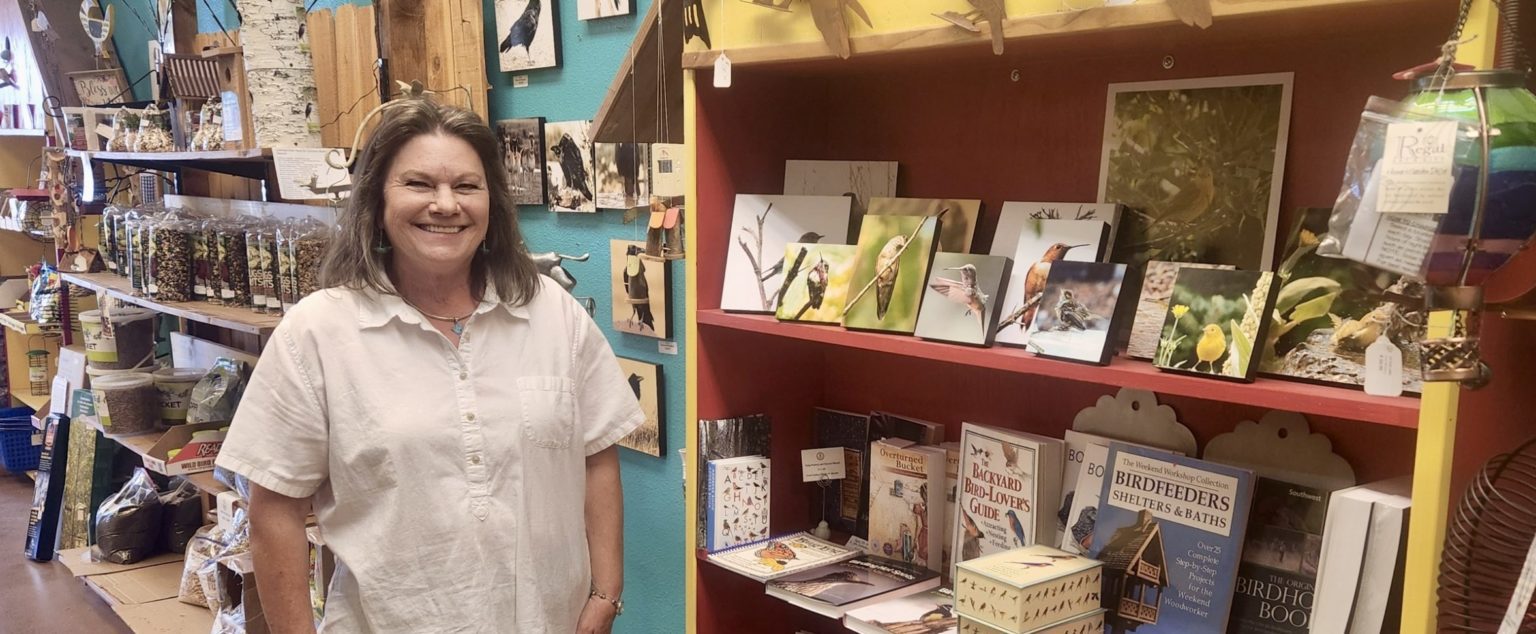New Mexico brings some of the most breathtaking wild birds during the fall migration and is one of America’s greatest wildlife showcases of the year.
Birders from all over the country come to watch and capture photos of the species that reside and migrate along the Bosque and Rio Grande, mostly from the months of September to December.
New Mexico has one of the highest bird species lists in the nation, according to the NM Audubon Society.
Jim and Linda Murray, owners of Wild Bird Seed Trading Company, said it can be a great activity to start feeding and watching wild birds as they pass through, and can give a sense of accomplishment and fulfillment when one can help these feathered friends along their way while taking in the unique nature of the state.
There are two versions of their blends, to include sunflower seeds or not. It can be less messy to not get it included, but can also be a surprise to eventually end up with some sunflower stocks in the yard. The blend recipe also changes throughout the year, so that birds get the nutrients needed to get through the cold winter months.
“We are passionate about nature and feel blessed to have like-minded customers and friends who share this enjoyment with us,” the Murrays explained.
Wild Bird Seed has everything anyone would need to start their own bird feeding routine, including a large selection of feeders, bird baths, bird houses, local art, home and yard accents, and educational information. Canvas bird photos taken by Linda are featured throughout the store with photo note cards from local photographer Jan Noah.
Linda said the most crucial thing they encourage for people starting out is to feed their birds year-round, because there are many species that hunker down here during the winter months and have become acclimated to the area with little in the way of natural food resources.
“During the dormant season, it is the most valued time to help the birds with a high fat and protein diet, found through a quality seed and supplemental foods such as suet, bark butter and feed blocks,” she said.
Researchers are always monitoring bird migrations and populations in New Mexico, but especially the ones who are becoming acclimated to staying here more recently throughout the year.
Linda explained that if people do start to feed the birds in their yards, they also need to make sure to give birds a good water source, which can be done by using something as small as a propped-up planter tray or a bird bath. It is also advised that if people use seed and feed hummingbirds, to put these feeders in separate areas of the yard, so there are no issues for the smaller hummingbird species that come through.
To deter natural predators like cats, who do not like the scent of citrus, putting lemon or orange peels sprinkled throughout the areas with feeders periodically can stop them from coming around and save the birds in your yard from becoming their prey.
About 500 of the world’s 10,000 bird species have been reported over the last 100 years in New Mexico, according to nmnaturalhistory.org. Seventy percent of birds in North America migrate, and more than 80% of them make their seasonal flights at night.
The Pacific Flyway, along with three other major flyways in the nation, all converge through Mexico down into Panama and diverge again along other routes through South America. Not all birds make it as far as the equator, but some species that migrate can also come from places as far north as Alaska, Canada and even the North Pole.
“Their very shephard-like to the other birds; I’ve seen them act hysterical at the feeders screaming at the other birds, and when I went out there, there was a prairie rattler, so he was doing what he was supposed to do,” she said.
Linda takes photos of the birds her feeders bring to the shop and in her own yard, which are great accent pieces or gifts for family and friends, she said.
Their favorite place to go bird watching is at the Randall Davey Audubon Center and Sanctuary in Santa Fe, as it is more than 135 acres of land dedicated to wildlife preservation and brings some of the most diverse bird varieties in the state.
She said in northern New Mexico, from Santa Fe to Taos along the Rio Grande, one can sometimes find bald American eagles migrating from Colorado, but especially in the area of Questa, where many come to nest and feast at the fish hatchery.
For those wanting to get started feeding birds in their yard, a stop at Wild Bird Seed is a good start. They will educate you on what you need, tell you what to expect, have sample bags of their special seed blends and even have a free rewards frequent buyer program for their regulars (after 15 visits of $10 or more customers can get $25 off any product in the store).
To check out what Wild Bird Seed Trading Co. has to offer, go to 12611 Montgomery Blvd. NE Suite A-8, from 10 a.m. to 3 p.m. Monday through Saturday.
Best bird watching locations and helping with conservation
For a list of places within the city and nearby to check out the bird migration this fall, see below.
Places to see migrating birds
Bosque Del Apache National Wildlife Refuge Center – Just south of San Antonio, New Mexico Highway 85
This refuge, located in Socorro County, has one of the largest populations of cranes in New Mexico from September to December as these birds love the lakes in the 30,000 acres dedicated to wildlife. There are tens of thousands of cranes, geese and ducks who flock there each winter. Established in 1939, it is one the oldest and largest bird sanctuaries in the state. Patrons can drive around or bike to the many areas where birds can be found. There is an annual Festival of the Cranes Dec. 1-3.
Sandia Crest – End of Sandia Crest Highway 536
Take the scenic drive during the fall foliage up to the crest, where hundreds of smaller bird species thrive. Parking is $3 and worth the views to hike to Kiwanis Cabin.
In Albuquerque (* locations are usually havens for Sandhill Cranes)
* Valle Del Oro National Wildlife Refuge, 7851 Second St. SW
Rio Grande Nature Center State Park, 2901 Candelaria Road NW (parking cost $3)
* Open Space Visitor Center Bosque Trail Access-way, 6500 Coors Blvd. NW
Elena Gallegos Open Space, 7100 Tramway Blvd. NE (parking cost $1-2)
* Los Poblano’s Fields Open Space, 6000-6018 Los Poblanos Field Trails/Montano NW
Bachechi Open Space, 9521 Rio Grande Blvd. NW
How people can join in conservation
Backyard Refuge Program
The Friends of Valle Del Oro National Wildlife Refuge has a backyard refuge program for migrating birds and local birds to have safe habitats in New Mexico.
As of May, this year, the program has secured 78 acres from 200 local individual or business participants.
Most avian migrations follow along rivers, mountain ranges and natural landforms in addition to urban areas, and this program encourages people to pledge part of their own spaces by providing wildlife gardens, or lots that can host trees or shrubs that benefit local and migrating wildlife. Also, they use homemade or natural pesticides like diatomaceous earth or boric acid so birds are not poisoned by pesticides.
Anyone can contribute by trying to garden for wildlife and landscape for conservation.
The wildlife refuge, which houses hundreds of species of birds, insects and other wildlife, hopes to reach its goal of 570 acres, matching the refuge site area, and can be a space as small as a deck garden or an acre lot.
To pledge and certify your space, or learn more about this program, click the link here.
The Great Backyard Bird Count
The Great Backyard Bird Count is an annual event and great way to spend an afternoon with the kids exploring the birds in one’s own yard but can also help researchers learn about bird populations all over the world. The count, held in February, is an international event where data collected is shown on a global map and participants can share photos of birds they’ve found.
For more information on this interactive global nature event, click the link here.


